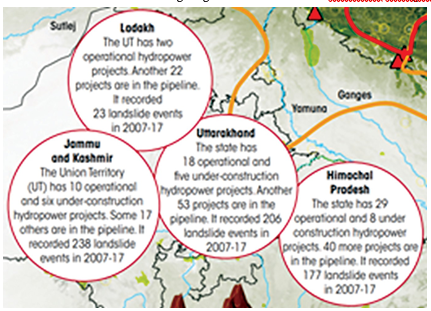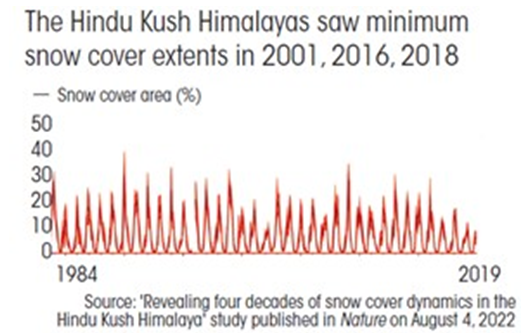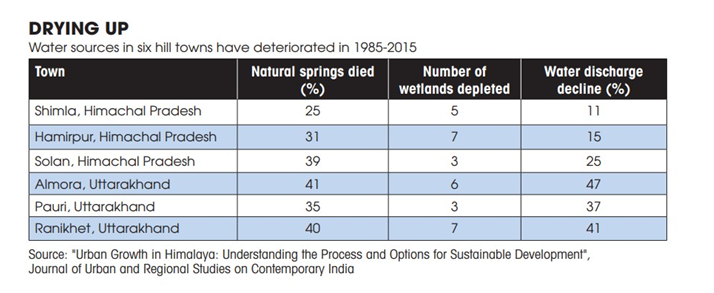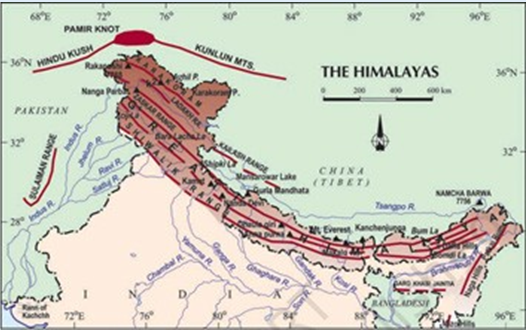Down To Earth(february1-15 2023)
1. FRAGILITY OF HIMALAYAS
- The Himalayas are often in the news due to one or the other natural disaster. Recently, the Joshimath crisis has once again put focus on the fragility of the Himalayas.
|
|
EXTRA BITSThe Himalayas
|
|
Data on Himalayan Disasters:
- The Himalayas have experienced 35% of the major disasters over the last 110 years.
- Between April 2021 and April 2022, the Geological Survey of India recorded 38 landslides in Himalayan states.
- Floods are the most common type of disaster in the region and since 1903 there have been 132 of the 240 floods in himalayas.
- The National Center for Seismology, under the Union Ministry of Earth Sciences, states that Himalayan states have recorded 2,687 earthquakes between 2009 and 2021.

Reasons for fragility of Himalayas:
- The youngest mountain range in the world, they are highly prone to erosion
- Due to continuous upliftment of the mountain, the region falls in a very high seismic zone thus susceptible to natural disasters like earthquakes, landslides, subsidence etc.
- Unfettered and unplanned infrastructure projects in the region, warming of Himalayas faster than the rest of the country and vulnerability to climate change.
- There is a lack of systematic studies on the challenges in the region.
2. UNPLANNED GROWTH
- Himalayas is one of the densely populated mountain ranges in the world, with urban centers serving as the centers of growth. Unplanned growth has been a key factor behind increased disaster incidents in the Himalayas.
- Extent of Unplanned Growth:
- Urban population in Himalayan states grew to 24% in 2021 from 11% in 1971.In places like Uttarakhand buildings can be seen constructed on either old landslide debris like Joshimath or near rivers.
- Bhuvan satellite data (by ISRO) shows just between 2013 and 2015, Himalayan states lost a substantial forest chunk, with Uttrakhand and Nagaland losing the most; over 200 sq km of forests.
Effects of Unplanned Urbanization:
- It has altered the hydrology of the towns and cities due to which rainfall is now lost through surface run-off, which has led to drying up of springs and lakes. Eg: the capacity of Bhimtal and Nainital lakes has decreased by 5,494 cubic meters and 14,150 cubic meters during the last century because of rapid siltation.
- Impact on food and water security is particularly visible as towns like Shimla run out of water, guzzle energy
- and experience several hours of traffic jams.
- Schemes like Chardham Project, PRASAD etc promote sustainable tourism but its seldom followed.High tourism also affects sanitation systems and creates waste piles in the region.
3. MEGA PROJECTS IN HIMALAYAS
- Himalayan region is regarded as the powerhouse of India due to abundant waterbodies and ideal topography. But at the same time disasters linked to hydropower projects in the Himalayan region have become more frequent in recent years.
Major Projects:
- Himalayan hydro plants currently have installed capacity of 46,850 MW and have a potential to generate 115,550 MW as per government estimates.
- According to the Central Electricity Authority —till November 2022, Himalayan States had 81 large hydropower projects (above 25 MW) and 26 projects under construction, and another 320 large projects in the pipeline.
Project |
Capacity (MW) |
River |
|
Tehri Stage 2 |
1000 |
Bhagirathi river |
|
Tapovan Vishnugad |
520 |
Dhauliganga river |
|
Vishnugadh Pipalkoti |
444 |
Alaknanda river |
|
Singoli Bhatwari |
99 |
Mandakini river |
|
Pare Hydro Power Station |
110 |
Dikrong River |
|
Kameng Hydro Power Station |
600 |
Bichom and Tenga Rivers |
|
Panyor Lower Hydro Power Station |
405 |
Ranganadi River |
Disaster events in the region of hydro plants:
- In 2012, flooding in Assi Ganga river damaged the Assi Ganga hydroelectric projects (hep) 1 and 2.
- The 2013 Kedarnath floods severely damaged Phata-Byung, Singoli-Bhatwari, and Vishnuprayag projects.
- In 2021, a rock and ice avalanche entirely destroyed the Rishi Ganga project and severely damaged the Vishnugad- Tapovan hydel project.
- On December 19, 2022, a significant slope failure occurred at the Urni landslide zone in Kinnaur district of HimachaPradesh, where construction works have been going on at the 1,091 MW Karcham Wangtoo hydroelectric plant.

Reasons of such disasters:
- Although most projects are run-of-the-river projects, yet when same mountain range is drilled without a break, safety of the region gets affected.
- There is very little understanding of the landscape in the scientific studies that are done for feasibilitytechnical and environmental clearances.
Impact of such disasters:
- When underground springs start disappearing, irrigation and drinking water availability gets affected, along with the safety of the village affected and there is indirect displacement.
- Recurrent disasters, clearance hurdles, opposition from local residents have made hydropower generation economically unviable and power generation from hydropower is showing diminishing returns for developers.
- Bad loans in the hydel power projects is high and the cost of the power is high and none of the discoms are buying this power.
4. CLIMATE CHANGE IN HIMALAYAS
- Indian Himalayan region is spread across 13 states and union territories. Himalayas form one of the youngest mountain range in the world and is home to over 9000 glaciers which feeds the perennial rivers. As per the Wildlife Conservation Society-India, Himalayan region consists of 42 per cent forests that are home to 10,000 species of plants, 300 mammalian species and 977 bird species.
Data on climate change in Himalayas:
- The region is warming at aa rate of 0.15-0.6 degree Centigrade per decade, which is higher than the mean global warming rate of 0.074°C per decade.
- The annual mean surface air temperature in the Hindu Kush Himalayas, has increased at a rate of about 0.1°C per decade during 1901–2014, increased to 0.2°C per decade during 1951–2014, which is attributable to anthropogenic climate change.
- Himalayan snow cover and glaciers have shrunk 10 times faster over the past four decades than in the previous 700 years.
- The warming climate has altered the precipitation in the region. Almost 60 per cent of 132 floods (between1900-2002) took place in the last two decades (2003-2022), suggesting an increase in the frequency.
- According to the Inventory and Revival of Springs in the Himalayas for Water Security released by the Niti Aayog in 2018, approximately 50 per cent of the 3 million springs in the region have already gone dry.

Reason and Indicators of Climate Change:
- Increased levels of pollutants, such as black carbon, at higher altitudes as a result of human activity.
- These pollutants, released due to the use of fossil fuels which settle on the snow cover and absorb more sunlight, accelerate the melting process.
- While there is enough evidence to suggest that the glaciers are retreating, little information exists on whether they are also losing mass, which is a better indicator of shrinking glaciers.
- The changing climate is also impacting the permafrost. A thawing permafrost could make slopes vulnerable to erosion and deposit debris and sediment onto nearby rivers, thereby destroying homes and could trigger landslides.
Impacts of climate change on Himalayas:
- Glaciers feed the river systems and their thinning would mean less water in the rivers in the long run.
- The rapid melting of glaciers can trigger disasters like glacial lake outburst floods. This phenomenon is caused by the sudden outflow of water from glaciallakes. Eg: 2013 Kedarnath floods
- The warming climate is triggering forest fires in the region, which now occurs round-the-year in states like Uttarakhand thus altering the vegetationwhere fire-resistant tree varieties are thriving
- There has been mass movement and change of staying and breeding patterns in the local species of the himalayas. Eg: More heat adapted species are going up the slope.
5. SUSTAINABLE PRACTICES IN HIMALAYAS
- Himalayas have been under pressure due to climate change and unsustainable anthropogenic activities. It is high time to study and adopt sustainable practices to avoid calamity.

Sustainable Practices and Guidelines:
- Carry out detailed study of area and systematic calculations based on carrying capacity of the region.
- High energy demands can be avoided by following building norms in the Himalayas such that they provide thermal comfort through layout, building design and choice of materials.
- Reviving and promoting traditional construction technologies for developmental works like Kath-kuni, Dajji Diwari and Koti banal found in Himachal Pradesh, Uttarakhand and Jammu and Kashmir.
- Pahal published by the UN Development Programme in 2016, documents different types of constructions suitable for particular zones in some states like Assam,Himachal Pradesh, Manipur and Tripura, which can be considered as a template.
- To rejuvenate and save water resources techniques such as watershed management, rainwater harvesting and spring rejuvenation that need to be documented, studied and protected. Eg: Sikkim in 2008 launched the Dhara Vikas programme, through which revived 700 springs in five years with participation from civil society members and communities.
- Tourism should come with a sense of responsibility. Initiatives to promote homestays, a traditional hospitality practice in the Himalayan region, in states like Uttarakhand can be promoted and residents must be educated.
Impediments to sustainable practices:
- Lack of study to gaze at the impact of bumper to bumper projects (projects where the head of one starts at the tail of the other).
- The Himalayan ecosystem and its limitations are often ignored while constructing buildings. Small settlements particularly do not have much guiding principles and regulations.
- Less regard for management of natural resources and solid waste management despite the fact that urban settlements have expanded in size, area and complexity over the years. Majority of waste is unaccounted for and very little is treated properly.
Mains Questions
- In the light of the Joshimath Crisis in Uttarakhand, discuss the fragility of Himalayan Region. Also suggest ways for sustainable growth in Himalayan States.
QUICK LINKS
